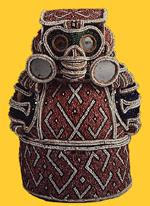
On October 19-20, 2007, Michigan State University College of Law was fortunate to host the 4th Annual Indigenous Law Conference. This year, the theme was American Indian Law and Literature. My thanks to Matthew Fletcher and Wenona Singel for an excellent conference. My own contribution to that event focused on my work in Latin America, and specifically Latin American engagement in international law and national self constitution. What follows is an abstract and then an extended version of my presentation at the Conference. Comments and reactions, as always, are most welcome.
ABSTRACT: Indigenous peoples have been quite useful to political elites in Latin America almost since the time of the conquests by Spanish and Portuguese adventurers in the 15th and 16th centuries. In the 19th and early 20th centuries, indigenous people supplied the foundations for a trope, both literary and political, essential for the construction of cultural, ethnic, racial and political identities distinct from the traditional colonial masters of emerging Latin American states, as well as from that great power to the North. This paper looks at one aspect of this rich development by focusing on the "noble savage" and the construction of Caribbean (and principally Cuban) political identity and the formation of governance ideals. The heart of the paper examines essays of José Martí in the broader context of Latin indigenismo.
PRESENTATION:
I. INTRODUCTION
Indigenous peoples have been quite useful to political elites in Latin America generally, and in the Caribbean specifically, almost since the time of the conquests by Spanish and Portuguese adventurers in the 15th and 16th centuries. But they have been most useful dead. Or, where the vestiges of Taíno culture are hard to avoid, at least erased from living national memory. In their place, a political racialized mestizaje was deployed against the political purity of race deployed by North Americans in their quest to replace Spain as the dominant colonial power in the Hemisphere, and against Spanish race hierarchies of the colonial period.
Dead, the Indian could be transformed, generalized, denatured, and repackaged for the benefit of emerging elites. In the 19th and early 20th centuries, indigenous people supplied the foundations for a trope, both literary and political, essential for the construction of cultural, ethnic, racial and political identities distinct from the traditional colonial masters of emerging Latin American states, as well as from that great power to the North. This trope, in turn, was part of a larger discussion within Latin American pitting a mestisaje based political and literary theory among nations with large mixed populations and a more North American perspective in places like Argentina and Chile with smaller indigenous and African populations. Indigenismo thus fractured in meaning—pointing to either original peoples, or the blended post conquest populations, or the indigenous characteristics of a dominant European population in its new territory.
See full article at:
http://lcbackerblog.blogspot.com/2007/10/from-hatuey-to-che-indigenous-cuba.html
Indigenous peoples have been quite useful to political elites in Latin America generally, and in the Caribbean specifically, almost since the time of the conquests by Spanish and Portuguese adventurers in the 15th and 16th centuries. But they have been most useful dead. Or, where the vestiges of Taíno culture are hard to avoid, at least erased from living national memory. In their place, a political racialized mestizaje was deployed against the political purity of race deployed by North Americans in their quest to replace Spain as the dominant colonial power in the Hemisphere, and against Spanish race hierarchies of the colonial period.
Dead, the Indian could be transformed, generalized, denatured, and repackaged for the benefit of emerging elites. In the 19th and early 20th centuries, indigenous people supplied the foundations for a trope, both literary and political, essential for the construction of cultural, ethnic, racial and political identities distinct from the traditional colonial masters of emerging Latin American states, as well as from that great power to the North. This trope, in turn, was part of a larger discussion within Latin American pitting a mestisaje based political and literary theory among nations with large mixed populations and a more North American perspective in places like Argentina and Chile with smaller indigenous and African populations. Indigenismo thus fractured in meaning—pointing to either original peoples, or the blended post conquest populations, or the indigenous characteristics of a dominant European population in its new territory.
See full article at:
http://lcbackerblog.blogspot.com/2007/10/from-hatuey-to-che-indigenous-cuba.html










No comments:
Post a Comment